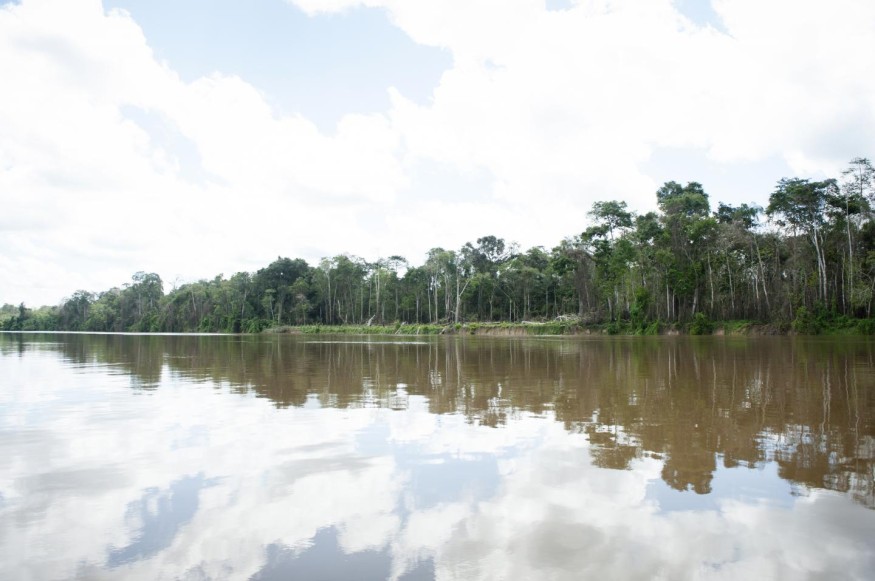
Besides swathes of destroyed vegetation, forest fires in Amazonia leave their imprint on the Amazon River and its tributaries. Incomplete burning of trees results in the production of black carbon, solid particles that enter the waters of the Amazon in the form of charcoal and soot and are transported to the Atlantic Ocean as dissolved organic carbon.
For the first time, an international group of researchers have quantified and characterized the black carbon flowing in the Amazon River. Their findings, published in Nature Communications, show that most of the black carbon transported to the ocean is "young" and probably results from recent forest fires.
"By radiometric dating [a method that quantifies the amount of carbon-14 or other naturally occurring radioactive isotopes present in material based on their known rate of decay to determine the material's age to about 60,000 years ago] and molecular composition analysis, we concluded that most of the black carbon we found in the Amazon River was produced in recent years by the burning of trees," said Jeffrey E. Richey, a professor at the University of Washington in the United States and a coauthor of the study.
As a visiting researcher at the University of São Paulo's Center for Nuclear Energy in Agriculture (CENA-USP), in the past five years, Richey has conducted a project supported by São Paulo Research Foundation - FAPESP under the auspices of its São Paulo Excellence Chair (SPEC) program, with the aim of elucidating the role of the Amazon River basin in the global carbon cycle.
In November 2015, during one of the driest seasons in the region, the researchers who worked on the project collected samples of black carbon dissolved in the main channel of the Amazon and in four tributaries - the Negro, Madeira, Trombetas and Tapajós.
This period was chosen for execution of the study because water levels were low and connectivity between the Amazon and its floodplain was limited. "As a result, we were able to obtain samples only of permanent water and more accurately identify the sources of black carbon in the river basin," Richey said.
Molecular markers
Carbon-14 levels and contents in samples were measured using molecular markers, such as the polycarboxylic acid released by oxidation of aromatic polycyclical hydrocarbons in black carbon.
Quantitative measurement of the markers was combined with molecular characterization of the samples using ultra-high-resolution mass spectrometry.
The results of the analyses showed that the black carbon dissolved in the Amazon and its tributaries is generally "young" but ages as it proceeds toward the ocean.
Samples collected in localities relatively distant from the Atlantic, such as Óbidos in Pará State, were younger, while those collected farther downstream were older.
"This suggests the black carbon may age as it moves from dry land to the river and then flows on to the sea. Also, more reactive components may be removed during the transportation of this material," Richey said.
"The more recent material may be submitted to a process of mineralization in the river as it flows to the sea. This could cause a change in its molecular profile so that it emits an 'older' signal. There are still various aspects of the storage and transportation of this material from dry land to rivers and then the ocean that we need to understand better."
In a new project, also supported by FAPESP, the researchers plan to perform a larger number of measurements for comparison with the data for 2015 in an effort to find out whether the production of "young" black carbon and hence the frequency of forest fires have increased in recent years.
"Concern about the recent burnings in Amazonia is particularly acute with regard to the carbon generated. Part of it goes into the atmosphere in the form of carbon dioxide, but a large proportion is retained in the soil or water in the form of black carbon," Richey said.
Largest source of organic matter
According to the researchers, the Amazon River accounts for one-fifth of global freshwater discharge to the oceans and is the largest single source of seaborne terrestrial organic matter, "exporting" between 22 and 27 million metric tons of dissolved organic carbon per year on average. For this reason, it is a crucial system through which to understand the cycling and transportation of black carbon, the most stable carbon compound in nature.
A large and refractory component of the global carbon cycle, black carbon in particulate form acts as a biospheric carbon sink by removing carbon from faster atmosphere-biosphere processes and storing it in sedimentary reservoirs. Knowledge of the origin, dynamics and fate of this material is essential to the development of models for predicting how the global carbon cycle may interact with climate change, Richey stressed.
"Our understanding of the role of black carbon at the regional and global scales is inadequate, owing largely to limited knowledge of the processing, quality and fate of dissolved black carbon during its exportation by rivers to the ocean," he said.
"For example, we need to know how long the black carbon produced by recent forest fires takes to reach the Amazon River."
© 2025 NatureWorldNews.com All rights reserved. Do not reproduce without permission.





